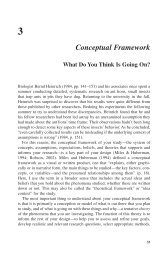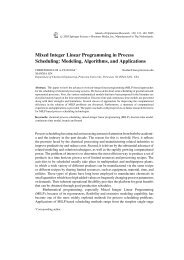Qualitative Research Basics: A Guide for Engineering Educators
Qualitative Research Basics: A Guide for Engineering Educators
Qualitative Research Basics: A Guide for Engineering Educators
Create successful ePaper yourself
Turn your PDF publications into a flip-book with our unique Google optimized e-Paper software.
It is a good habit to review one's data daily during collection to make sure raw notes are<br />
edited into a <strong>for</strong>m that will be usable even after time has dimmed the memory of the<br />
actual experiences of the day. Expanded notes that add the detail that there was not time<br />
enough to note while collecting data are written frequently by researchers in the pauses<br />
between data collection activities during a study.<br />
A second activity that needs to take place right from the start of data collection is data<br />
storage and organization. Given the large volume of text that normally accrues from a<br />
qualitative study, even the most casual researcher has to adopt structured habits <strong>for</strong><br />
labeling data in standard fashion (who, when, where, pagination, file name, and the like)<br />
and keeping it safe (according to Human Subjects confidentiality agreements) and with<br />
like pieces (such as in binders, electronic file folders or drives, or in labeled paper folders<br />
in a locked file cabinet).<br />
Reviewing and Selecting Data<br />
As data accumulate, the more the researcher reviews them, the easier subsequent work<br />
becomes. Some of the data collected in a qualitative study, especially the data collected in<br />
the early period of a study be<strong>for</strong>e the focus was narrowed, will be peripheral to the main<br />
research questions. Interview transcripts will contain whole pages that document times<br />
when the interviewee strayed from the subject or digressed into an amusing but not<br />
relevant memory. Field notes will often contain laborious descriptions of the actions of a<br />
participant who later dropped out of the study. These data segments are candidates <strong>for</strong><br />
what some researchers call “data reduction.”<br />
Deciding what data are most pertinent to the study, however, is not always<br />
straight<strong>for</strong>ward and requires the judgment of the researcher. Like all other analysis<br />
activities, selecting useful data from the total data collected is an activity that depends on<br />
the care and sensitivity that the researcher brings to it. <strong>Research</strong>ers vary in their selection<br />
decisions, some finding that they can reduce the amount of data they analyze at an early<br />
stage without damaging its integrity, and others feeling that they must work with a larger<br />
amount of data through the whole process. While data not considered relevant at the start<br />
of analysis can be set aside as other data become the main focus, they should not be<br />
destroyed in the event that their importance only becomes clear as the analysis proceeds.<br />
Sorting the Data into Categories<br />
As data are selected <strong>for</strong> further analysis, the researcher develops a sense <strong>for</strong> the ways in<br />
which they can be fitted together. Often, a preliminary sort can be made on the topics that<br />
were explored through the observations or interviews. These may correspond to interview<br />
questions when structured interview <strong>for</strong>mats are used. For example, all comments in the<br />
interviews on first-year students who abandoned engineering as a field of major study<br />
might be placed in such preliminary categories as “perception of lack of fit,” “academic<br />
issues,” “time management,” “financial,” or the like. Selecting a comment is called<br />
“chunking,” and deciding how much or little of a given text should be selected <strong>for</strong><br />
classification is a decision made on the basis of the type of study. For standard studies (as<br />
44
















